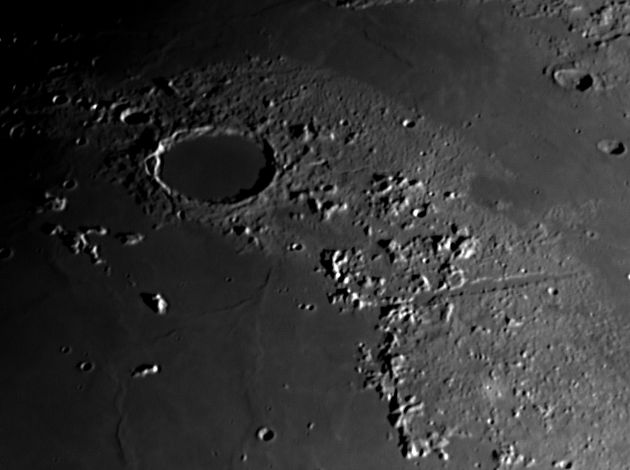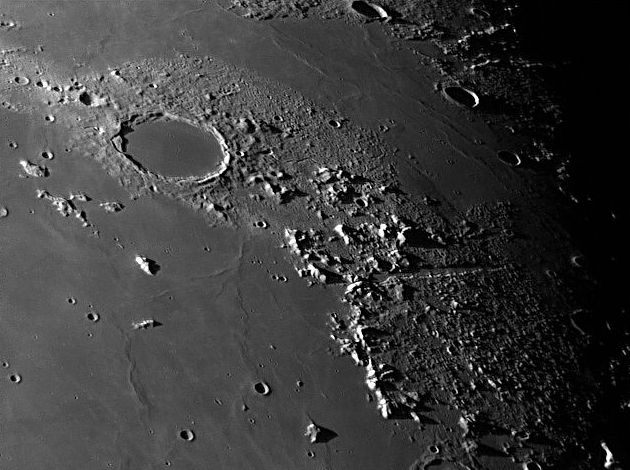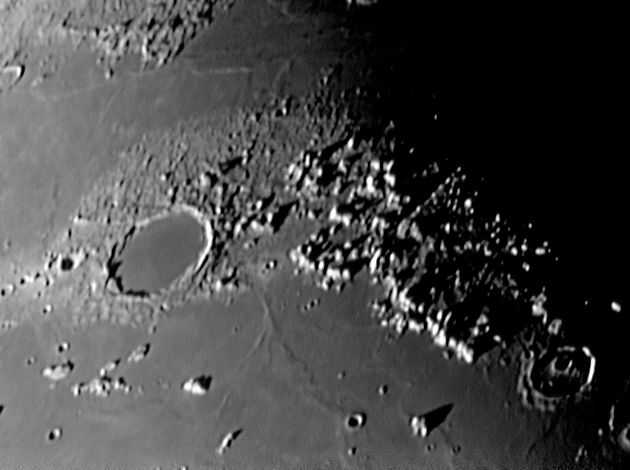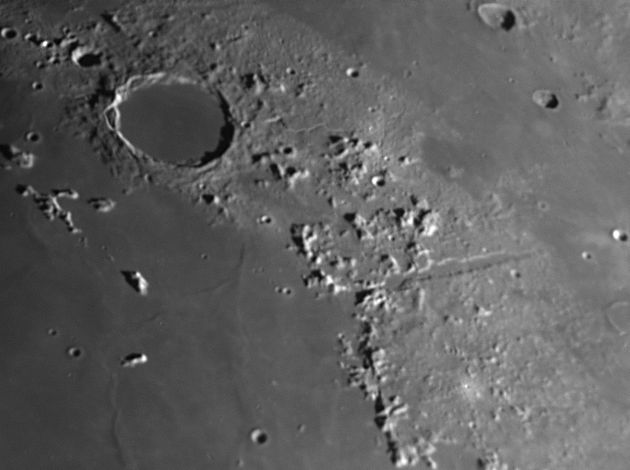

Move your mouse over the picture to see the names of the various craters.

Considering the size of the Imbrium basin, the Alps are a relatively small mountain chain. They extend for only about 250 Km and the highest peak (aptly named Mont Blanc) rises to only 3,600 metres. Compare this with the Apennines, 600 Km long and rising to 5,400 metres. Cutting through the mountains is the Alpine Valley, a remarkable cleft cutting right through the range and the rubbly foothills to their north-east. The large crater Plato more or less marks the northern end of the Alps.
The picture was taken with a ToUcam attached to my LX200 on 10th December 2005, when the Moon was 9.8 days old.
Lunar Phase: 60.1°
Colongitude: 25.5°
Date and Time: 10th December 2005 17:26 UT
Camera: ToUcam 740K
Telescope: LX200 at prime focus and IR-pass filter
Capture: K3CCDTools. Low gamma, 1/25", 10% gain, 483 frames
Processing: Registax. 182 frames stacked. Wavelets 1 = 10, 2 = 5

A new picture of the same area taken with the light coming from the other direction.
The picture was taken with a DMK camera attached to my LX200 on 31st August 2010, when the Moon was 20.6 days old.
Lunar Phase: 288.3°
Colongitude: 168.4°
Date and Time: 31st August 2010 04:41 UT
Camera: DMK 21AF04
Telescope: LX200 at prime focus and IR-pass filter
Capture: ICCapture. 1/108", gain 716, 3036 frames
Processing: Registax. 100 frames stacked. Wavelets 1 = 10, 2 = 5, gamma 1.2

This is essentially the same area but a little later in the lunar day. The Sun has only sunk about 4° in the lunar sky but it makes a big difference to the length of the shadows. The Alpine Valley is deep in shadow, but Plato is some 12° further west and is still in sunshine and the western rim is casting some nice shadows onto the floor. The shadow of Mount Piton shows what a steep and isolated mountain it is sticking out of the lava that fills the Imbrium basin.
The picture was taken with a ToUcam attached to my LX200 on 12th December 2006, when the Moon was 21.7 days old.
Lunar Phase: 274.9°
Colongitude: 172.3°
Date and Time: 12th December 2006 04:00 UT
Camera: ToUcam 740K
Telescope: LX200 at prime focus
Capture: K3CCDTools. High gamma, 1/25", 20% gain, 468 frames
Processing: Registax. 8 alignment points, 448 frames stacked. Wavelets 1-2 = 10, gamma = 1.3, histogram 15-200

Here is a new picture of this area taken on Day 8.8 when the libration was particularly favourable for the north-west limb. Craters Pico B, C, D (and others not shown here) are unusual in that no crater Pico exists; they take their names from Mons Pico, as does the mountain Mons Pico β
The scale markers are approximately 50 Km north and west, and apply at Alpes A (a crater named after a mountain range).
The picture was taken with a DMK camera attached to my LX200 on 27th December 2017, when the Moon was 8.8 days old.
Lunar Phase: 72.3°
Colongitude: 24.7°
Libration: +6° 56' in latitude, -7° 49' in longitude
Date and Time: 27th December 2017 19:12 UT
Camera: DMK 21AF04
Telescope: LX200 at prime focus
Capture: ICCapture. 1/618", gain 727, 1800 frames
Processing: Registax6. 16 alignment points, 100 frames per point stacked. Wavelets 1-2 = 5, gamma = 1.3
Home Back to NW Quadrant